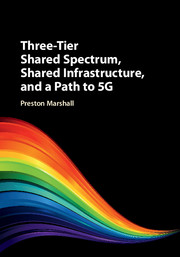Book contents
- Frontmatter
- Contents
- Acknowledgments
- Preface
- Part I Spectrum Sharing Background
- Part II Three-Tier Dynamic Spectrum Models
- Part III Components of a Three-Tier Architecture
- Part IV Protection Processes for Incumbents and Peers
- 8 General Process for Database System Operation
- 9 Protection of Incumbent Satellite Operations
- 10 Protection to and From Terrestrial Access Points and Point-to-Point Networks
- 11 Protection to and From Radar Systems
- 12 Coexistence Between Unprotected Peer Devices
- Part V Example Use of Three-Tier Spectrum: Use of the 3.5 GHz CBRS Band in the USA
- Part VI Future Bands, Network Services, Business Models, and Technology
- Part VII Appendices
- Index
- References
11 - Protection to and From Radar Systems
from Part IV - Protection Processes for Incumbents and Peers
Published online by Cambridge University Press: 30 August 2017
- Frontmatter
- Contents
- Acknowledgments
- Preface
- Part I Spectrum Sharing Background
- Part II Three-Tier Dynamic Spectrum Models
- Part III Components of a Three-Tier Architecture
- Part IV Protection Processes for Incumbents and Peers
- 8 General Process for Database System Operation
- 9 Protection of Incumbent Satellite Operations
- 10 Protection to and From Terrestrial Access Points and Point-to-Point Networks
- 11 Protection to and From Radar Systems
- 12 Coexistence Between Unprotected Peer Devices
- Part V Example Use of Three-Tier Spectrum: Use of the 3.5 GHz CBRS Band in the USA
- Part VI Future Bands, Network Services, Business Models, and Technology
- Part VII Appendices
- Index
- References
Summary
Unique Aspects of Radar Systems
Although most spectrum sharing discussion revolves around communications services sharing with communications services, radars consume massive amounts of spectrum, and meaningful spectrum sharing will require that this spectrum be meaningfully shared. Technical and operational issues impacting consideration and implementation of radar and communications spectrum sharing are many, including:
• Radars have very high peak power, and also very high gain antennas, so their interference potential could appear to be quite significant over an extensive region.
• Radars are often used for safety of life (aviation, maritime) or national security (military) related applications, so the tolerance for interference is low or non-existent.
• The emission characteristics of some radars are not publicly available from the Government or military users, and thus sensing design for detecting some radars is difficult. Others are so variable in pulse structure and scanning patterns that they are essentially random to the sensor designer. Similarly, the interference susceptibility of these radars is also not publicly available for use in determining protection modalities.
• Military radar users are concerned about the detection of some of their operations and characteristics.
• Although the transmission duty cycle for a radar is very low, the radar is “using” the spectrum while it is listening for a return signal, and is impacted by interference for a period twice the time it takes light to reach the outer radius of the radar.
• Bi-static radars have receivers that are not located at the same location as the transmitters (the illuminator), and therefore the angle or distance to these radar receivers cannot be determined by a sensing regime.
For these reasons, other than the Dynamic Frequency Selection (DFS) band at 5 GHz, there are few success stories for radar spectrum sharing.
A General Model of Radar System Design and Performance
This section introduces some basic parameters of radar operation, with only the factors related to the detection, protection, and mitigation of interference from radars considered. In most cases, the models are fairly simple radar modes of operation. Specialized military and space-borne radars have typically much more complex operational modes, but still have the basic characteristics provided in this discussion.
Information
- Type
- Chapter
- Information
- Publisher: Cambridge University PressPrint publication year: 2017
